It has been almost two months since the Sir Chris Hoy Velodrome was packed with riders, bikes, rollers and the smell of Scottish Championship success at the Scottish National Youth and Junior Track Championships.
We asked Event Organiser Carole O’Hare what it takes to organise a Scottish National Track Championships…
“I jokingly said at the Scottish National Senior Track Championships last year that I would see how I got on with the entries at Track League (Carole is a member of the Track League Organising Committee) and would look to help with the Championships next year. Track League finished, and then a few months later “the email” came in asking if I would like to organise the Scottish Youth and Junior Track Championships. I said yes.
The dates were already confirmed and the track booked, so I didn’t have to worry about that. The first thing I did was book first aid cover, partially so I wouldn’t forget at a later date, and then the next important job - I ordered safety pins! (those of you that know anything about racing will know that safety pins are instrumental!) I prefer the 34mm ones.

However, the best bit of advice I can give to anyone is to set up a separate email address which will only be used for that event – don’t’ be naïve in the amount of questions you think you will get asked! I had a meeting with the National Events Manager at Scottish Cycling, Sarah Macintyre, and we discussed the recent changes to the Youth Omnium Championship and the Championship events the Juniors may be riding the same weekend. Along with this, Sarah equipped me with the 2016 Championship schedule, technical regulations and really helpful guidance on planning a track race schedule – a bit of advice I’d give would be, don’t be afraid to ask for help, cycling events have been run before!
Scheduling can be a bit of an art, especially with Youth and Junior riders. They tend to enter everything and most haven’t gone down a sprint or endurance specific route yet, so you try and take that into account when planning. You could compare it to doing a table plan for a wedding or work event, you always know there are certain ones you can’t sit next to each other! When planning the timings, I looked at the previous year’s entrants, worked out who from the previous entrants had moved up as seniors and also who I knew was active at the moment that I thought would enter.
I was then introduced to the Chief Commissaire and the Race Secretary for the event and my proposed race schedule was submitted for checking. This was the most nerve racking part and can only be compared to waiting on exam results! Thankfully I only need to make a few small amendments to the schedule so it could be used on the British Cycling event management system for race entries.
Once the entries opened, I worked on recruiting volunteers for all the roles required over the weekend of the event and the first draft of the event manual. There are quite a few things which cannot be finalised until entries close, so I tried to plan getting as much as possible started and completed as far as I could until this point. Lots of lists and spreadsheets were required!
Entries closed with the usual flurry of last-minute entries with seconds to spare. Eligibility checked for all the riders and then entries accepted. The completed entries file was then sent to the Race Secretary who allocated all the rider numbers, and along with the Chief Commissaire, the race schedule was finalised.

The final two weeks leading up to the championships were the busiest. Getting the event manual finished and sending it to all the riders, making rider packs for sign on and confirming with all the volunteers the roles they would be doing. I also had to agree the track centre layout and the extra equipment I would need with the venue.
From then on it was a step by step process to get through the weekend:
- Set up track centre (discover the trolley was too big for all the lifts, which meant lots of extra improvised trips from the store)
- Welcome and brief volunteers
- Welcome officials and check if they need anything
- Event opens and racing starts (subconsciously worry and wait for the big obvious thing you have forgotten)
- Remember to make sure everyone eats and drinks (including yourself!)
- Event finishes, thank everyone and pack up!
As the weekend and event drew to a close I was both relieved and exhausted. The Monday after the event I can quite honestly say that I didn't want to see another bike race again.
However, on Tuesday after a good sleep I was proud of what I had done and was starting to make lists of things I would change or not do the next time. I think my name is pencilled in for another one possibly already!
I’d like to thank you to Sarah (Event Manager) and the rest of the team at Scottish Cycling for giving me the opportunity and for answering all my constant questions; also the Commissaries and timekeeping team who answered my questions and kept me on the right track (pardon the pun) and on time. Not to mention the Competition Managers who helped everything just run and were able to explain the technical parts when I couldn't.
Then there is the army of volunteers, many of which were put into new roles and just got the job done; without you the event simply couldn't go ahead.
Parents - thank you for allowing the riders to enter and all the taxi duties with all of the kit to get them to the event. And finally the riders - thank you for racing. If you don't race we can't put on an event!”
If you’re interested in knowing more about how you can get involved in organising an event at the Sir Chris Hoy Velodrome, get in touch with the Scottish Cycling Events Team at events@scottishcycling.org.uk.







